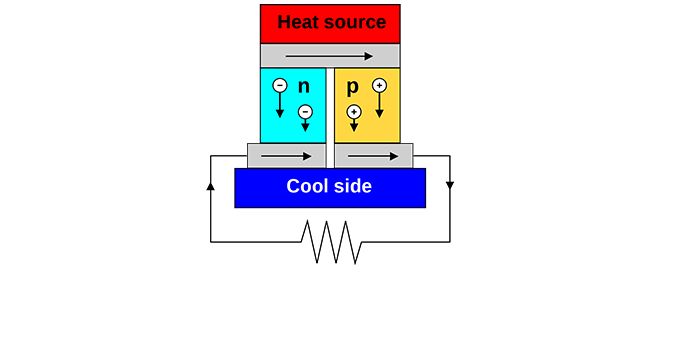Thermoelectric materials have long held the potential to provide clean alternatives for current energy sources. Efficient energy sources are becoming crucial due to the environmental damage sustained from rising greenhouse gas emissions.
 Thermoelectric Materials Lead to Cleaner Energy
Thermoelectric Materials Lead to Cleaner Energy

Scott Huntington | Off The Throttle
Renewables are vital in the fight for cleaner energy, and thankfully, they're available in numerous forms. Global ecosystems will benefit from a wide array of substitutes to replace conventional power sources. Thermoelectrics are increasingly viable options for improved electricity production, and a recent study has proven their effectiveness.
Halide Perovskites for Green Power
Scientists have recently performed experiments on halide perovskites to test and fine-tune their thermoelectric properties. These films are inorganic, tin-based materials that can conduct electricity through heat. Leaders in clean energy have previously suggested perovskites as capable thermoelectric conductors, but no comprehensive study has arisen until now.
The material's conductive properties are encouraged by self-doping, which introduces foreign matter into the film. Inserting chlorine into the surface layer of the perovskites adds free charges to the entire system and prevents bulk oxidation. The chlorine dopants in this study act as stabilizers and sacrificial sources for free charges.
Optimizing halide perovskites for commercial use can enable cleaner energy use on multiple levels. The study expands on using the films for light-emitting diodes, photodetectors and more once they become adapted to other compatible areas. A form of thermoelectric cellulose already exists, consisting of carbon nanotubes made from bacteria. Created by researchers at the Institute of Materials Science of Barcelona, this substance displays high flexibility and electrical conductivity.
Much like the halide perovskites, this conductive cellulose has the potential for applications in wearable gear and medical devices. These innovations in clean energy use can make thermoelectricity commonplace in homes, offices and healthcare centers. Powering the world could take significantly less electricity than it already does.
Other Forms of Clean Energy
Many forms of clean energy exist besides thermoelectric materials, including hydrogen fuel cells and biofuels. Scientists create biofuels from biomass, which can be anything from forest litter to algae. These fuels can replace the standard combustibles like gasoline and diesel, and they cost less to produce and distribute. Sorghum is a favorable crop for producing biofuel because of its versatility. The stalks contribute to feedstock for bioethanol production, while the seeds serve as food.
Hydrogen fuel cells create clean, efficient power and generate water, electricity and heat as their only products. They don't produce harmful emissions like traditional energy sources, making them carbon-neutral. Fuel cells also work faster than combustion engines, converting chemical energy to electric with a 60% efficiency rate. Because they don't wear out or require recharging, they can work for longer and keep operations flowing without interruption.
Even diesel serves a purpose in sustainable power. Large construction equipment and freight trucks require diesel to run — a complete switch to renewable fuel isn't always feasible. Clean diesel offers a practical compromise between harmful combustibles and non-toxic renewables. Clean diesel engines release fewer emissions and are more fuel-efficient than standard versions.
These engines take biodiesel instead of crude oil, a substance that often consists of animal fat and used cooking oil. Biodiesel has grown in prevalence as a clean option for large vehicles, with 2.8 billion gallons of it produced in 2016. Compact construction equipment, such as excavators and tractors, are best suited for these diesel alternatives.
Improved Thermoelectrics
Thermoelectric materials are undeniably useful in creating clean energy, but many sources are expensive and contain toxins. Scientists experiment with telluride components in limited amounts because of the material's high toxicity. These factors make it hard to implement thermoelectrics on a universal scale, but scientists and manufacturers continually work to improve these issues. The ideal form of thermoelectricity is cheap, accessible and contains little to no toxicity risk.
Copper iodide films offer other promising materials for facilitating conductivity. Copper thermoelectric modules work best for commercial and domestic applications, like wearable devices and windows. Transparent copper iodide elements produce a high enough energy density to power a generator or fridge all day. Electricity expenses would drop, but consumers would receive the same or better power generation.
Integrating copper iodide with various nanostructures can improve thermoelectric ZT. Nanocomposites and thin-film superlattices provide two examples of components this material can combine with for enhanced conductivity. Copper functions optimally at room temperature, making it ideal for use in homes. Refining these thermoelectric materials will allow broader assimilation of them in various industries.
Clean Energy Powers Lives
Global clean energy becomes a closer reality with every discovery in thermoelectrics, biofuels and more. Switching to sustainable electricity will shrink the energy grid and reduce the amount of gas-based power people currently rely on. A low-pollution planet could be possible with the development and acceptance of alternative energy.
If you like this article you may like "How Machine Learning Could Impact the Future of Renewable Energy"
The content & opinions in this article are the author’s and do not necessarily represent the views of AltEnergyMag
Comments (0)
This post does not have any comments. Be the first to leave a comment below.
Featured Product

